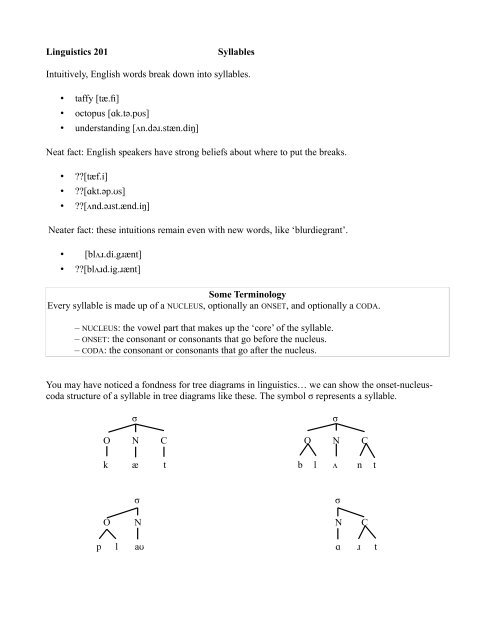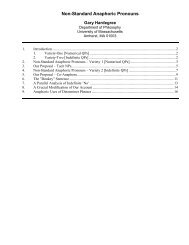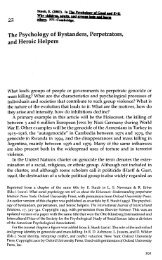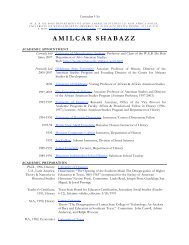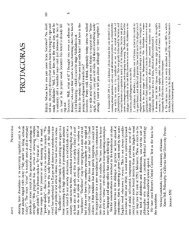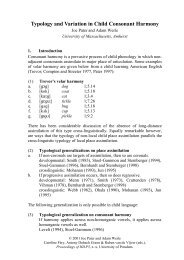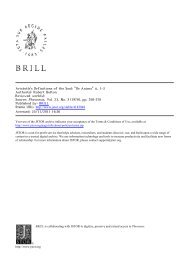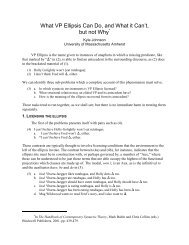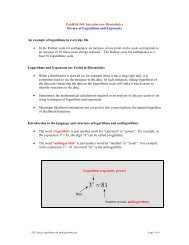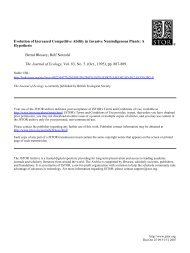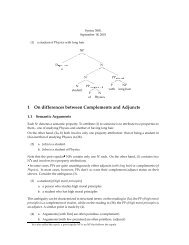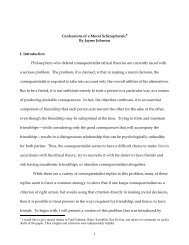Linguistics 201 Syllables Intuitively, English words break down into ...
Linguistics 201 Syllables Intuitively, English words break down into ...
Linguistics 201 Syllables Intuitively, English words break down into ...
You also want an ePaper? Increase the reach of your titles
YUMPU automatically turns print PDFs into web optimized ePapers that Google loves.
<strong>Linguistics</strong> <strong>201</strong><br />
<strong>Syllables</strong><br />
<strong>Intuitively</strong>, <strong>English</strong> <strong>words</strong> <strong>break</strong> <strong>down</strong> <strong>into</strong> syllables.<br />
• taffy [tæ.fi]<br />
• octopus [ɑk.tə.pʊs]<br />
• understanding [ʌn.dəɹ.stæn.diŋ]<br />
Neat fact: <strong>English</strong> speakers have strong beliefs about where to put the <strong>break</strong>s.<br />
• ??[tæf.i]<br />
• ??[ɑkt.əp.ʊs]<br />
• ??[ʌnd.əɹst.ænd.iŋ]<br />
Neater fact: these intuitions remain even with new <strong>words</strong>, like ‘blurdiegrant’.<br />
• [blʌɹ.di.gɹænt]<br />
• ??[blʌɹd.ig.ɹænt]<br />
Some Terminology<br />
Every syllable is made up of a NUCLEUS, optionally an ONSET, and optionally a CODA.<br />
– NUCLEUS: the vowel part that makes up the ‘core’ of the syllable.<br />
– ONSET: the consonant or consonants that go before the nucleus.<br />
– CODA: the consonant or consonants that go after the nucleus.<br />
You may have noticed a fondness for tree diagrams in linguistics… we can show the onset-nucleuscoda<br />
structure of a syllable in tree diagrams like these. The symbol σ represents a syllable.<br />
σ<br />
σ<br />
O N C O N C<br />
k æ t b l ʌ n t<br />
σ σ<br />
O N N C<br />
p l aʊ ɑ ɹ t
<strong>Linguistics</strong> <strong>201</strong> <strong>Syllables</strong> and phonotactic constraints<br />
The Syllabification Algorithm (first try)<br />
1. Scan the word and find the nuclei. Every vowel/diphthong is a nucleus (N). Every syllable has one<br />
nucleus. Draw a line from the N to the syllable level (σ).<br />
2. Gather consonants <strong>into</strong> onsets (O). A syllable may have an onset or it may not. Attach O to σ level.<br />
3. Gather up the remaining consonants <strong>into</strong> codas (C). A syllable may have a coda or it may not. Attach<br />
C to σ level.<br />
Notice that this correctly predicts which of the below syllabifications we get!<br />
• [tæ.fi]<br />
• ??[tæf.i]<br />
Constraints on onsets<br />
Some syllabifications are not just weird but completely impossible in <strong>English</strong>.<br />
• *[ɑ.ktə.pʊs] *[ʌ.ndə.ɹstæ.ndiŋ] *[blʌ.ɹdi.gɹænt]<br />
Intuition: there are some constraints on what can be a possible onset in <strong>English</strong>.<br />
• We can’t say [kt], [nd], [ɹst], [ɹd] at the start of a syllable.<br />
• Way of telling this: there are no <strong>words</strong> which start with these sequences of phones, and <strong>words</strong><br />
which start this way do not sound like <strong>English</strong>. (They’re not impossible in other languages:<br />
Russian кто [kto] ‘what’; the Ndebele people inhabit Southern Africa.)<br />
Constraints like this are called phonotactic constraints. We see similar constraints on codas, too. For<br />
example, *[kopl] is not a possible word of <strong>English</strong>, because [pl] cannot be a coda in <strong>English</strong>. ([kopəl] is<br />
a possible word, but splits [p] and [l] over two syllables.)<br />
The Syllabification Algorithm (revised)<br />
1. Scan the word and find the nuclei. Every vowel/diphthong is a nucleus (N). Every syllable has one<br />
nucleus. Draw a line from the N to the syllable level (σ).<br />
2. Gather as many consonants as possible given the phonotactic constraints of <strong>English</strong> <strong>into</strong> onsets (O).<br />
A syllable may have an onset or it may not. Attach O to σ level.<br />
3. Gather up the remaining consonants if the phonotactic onstraints of <strong>English</strong> allow it <strong>into</strong> codas (C).<br />
A syllable may have a coda or it may not. Attach C to σ level.<br />
b l ʌ ɹ d i g ɹ æ n t


